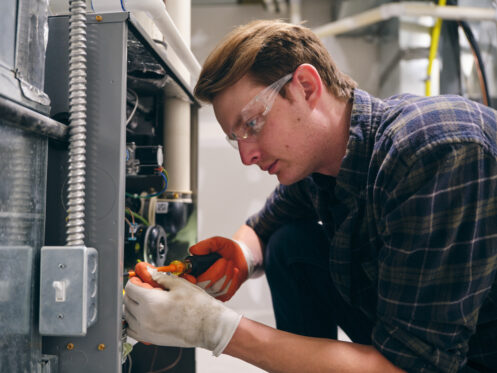A common mistake homeowners make with their furnaces is waiting too long to call for professional assistance. In the meantime, heating costs can rise, and the problem can worsen and become more expensive to fix. Additionally, a malfunctioning furnace may be unsafe, and you may even have to replace the system prematurely. Let’s explore when you shouldn’t delay and call a furnace technician immediately.
Rising Energy Consumption
A typical modern furnace has an annual fuel utilization efficiency rating of 80%. AFUE 80 means that a furnace successfully converts 80% of the fuel it burns into heat. It wastes the other 20%. When a furnace malfunctions, that ratio can change dramatically. This increases your household’s carbon footprint and fuel costs. That’s why you should monitor your fuel and electricity consumption monthly and annually. You may instead want to consider a smart thermostat with energy monitoring. It can alert you to usage spikes in hours rather than weeks.
Pilot Light Keeps Going Out
On older furnaces, a pilot light provides your furnace with a constant and consistent ignition source. When it’s not lit, the system can’t turn on as needed. A pilot light going out from time to time isn’t unusual. If you’re comfortable doing so, you can relight it. If you can’t relight it, call a professional. It could indicate a problem with the gas valve or the pilot light orifice or tip. You also shouldn’t ignore a pilot light that continues to go out.
In addition to the problems mentioned, when a pilot light often goes out, you could have a:
- Ventilation issue
- Bad gas regulator
- Cracked heat exchanger
- Dirty or faulty thermocouple
Pilot Light Burns a Color Other Than Blue
Pilot lights should burn blue. Any other color is a serious cause for concern and requires professional assistance. A small amount of yellow at the tip is normal. A full yellow or orange pilot light indicates fuel isn’t burning cleanly. It could be a dirty air intake or that the oxygen ratio for combustion is incorrect. If the color is red, green, or something else, it indicates a foreign substance in the mixture, such as:
- Oil
- Tar
- Dust
- Rust
Circuit Breaker Keeps Tripping
Furnaces often have a dedicated circuit breaker in the home’s electrical panel. This is true even with fuel-burning furnaces, as they require energy for the blower motor and other functions. Isolated trips usually don’t indicate a more serious problem. If a breaker trips, you can reset it once and see if it fixes your problem. If the breaker trips again, you shouldn’t continue to reset it. It can indicate a much more serious problem, and continued resets could cause further damage.
Furnace Won’t Turn On
One of the more obvious reasons to call a technician is a furnace that won’t turn on at all. We’ve already explored some of the most common reasons: pilot lights and circuit breakers. Another potential issue is a clogged furnace filter. If a clogged filter won’t let enough air in, the furnace may not start. Poor airflow can also cause overheating. Overheating can cause a furnace to prematurely shut off and then turn on again after it cools off. You shouldn’t continue to run a system behaving like that. Other potential issues include worn wiring, a faulty thermostat, and a bad flame sensor.
No Heat
Another common issue is a furnace that runs but gives no heat. Instead, it blows room-temperature air. Many of the problems discussed earlier can be the issue here as well. In this case, they’re just not interfering with the blower. Often, this is a thermostat issue. Make sure it’s set to heat and not another mode, such as cool or fan only.
Short Cycling
Cycling refers to how often a furnace turns on and how long it runs when it does. Note that cycles can vary depending on the brand, model, system capacity, size of the home, and weather outside. A typical cycle will be 10 to 15 minutes, two to three times an hour. If you notice your furnace turning on and off more frequently, it’s short cycling. It’s important to note that the causes of short cycling aren’t always serious. It could be as simple as a clogged furnace filter. Still, the result is quite serious as it drives up operating costs and causes wear and tear on the furnace.
Long Cycling
Long cycling refers to a furnace running for extended periods. This can be a thermostat issue, such as an inaccurate reading or bad signals to the furnace. Other common issues we’ve already mentioned, such as a clogged filter or duct leakage. It may indicate damage to the exhaust system. The problem can also be a dirty flame sensor or faulty heat exchanger.
Unusual Odors
The smells a furnace makes give you an indication that something is wrong. Note that a fleeting smell when a furnace cycles on is usually normal and not a sign of a problem. Any smell that bothers you or lingers does require professional attention. Often, smells suggest the system requires cleaning. There may be dust accumulation in the furnace or mildew in the ducts. A rotten egg smell comes from mercaptan in the fuel supply, which suggests a gas leak. Any smell you’d describe as metallic, plastic, chemical, or electrical is also a serious cause for concern.
Inconsistent Temperatures
Furnaces that suddenly provide inconsistent heating may be malfunctioning. If the problem is furnace-related, it’s often due to the blower. The blower may need lubrication, a new belt, or new ball bearings. You may notice squealing or other sounds as well. Other causes include a malfunctioning thermostat or a problem with your ducts, such as air leakage.
Poor Indoor Air Quality
A malfunctioning furnace can undermine your indoor air quality. This is common when the furnace doesn’t get regular maintenance and dust has accumulated. We’ve already discussed unpleasant odors, but air quality issues can manifest in other ways. That includes dust building up more quickly and excessively in the home.
Loud and Unusual Noises
Noises can indicate malfunction as well. Don’t ignore unfamiliar noises or sounds that are suddenly louder. Grinding and scraping sounds, for instance, usually indicate an early problem with a blower. If you call right away, it may just be a lubrication or bearing issue. Left unchecked, it could lead to blower damage. Other sounds to listen for include:
- Squealing
- Humming
- Thumping
- Pops and bangs
- Repeated clicking
Expert Furnace Service in Sioux City
Kalins Indoor Comfort has locations in Sioux City, Vermillion, and Yankton and has served the region for over 100 years. We work with both residential and commercial customers. Our technicians install, maintain, and repair furnaces, heat pumps, air conditioners, ductless mini-splits, and geothermal systems. We offer a membership plan so you can save money while having your heating equipment services on a regular schedule. Our team also installs, repairs, and seals ductwork. You can also count on us for smart thermostats, HVAC zone control, humidifiers, dehumidifiers, and fireplaces. Call today or contact us online with any questions or to schedule an appointment.











